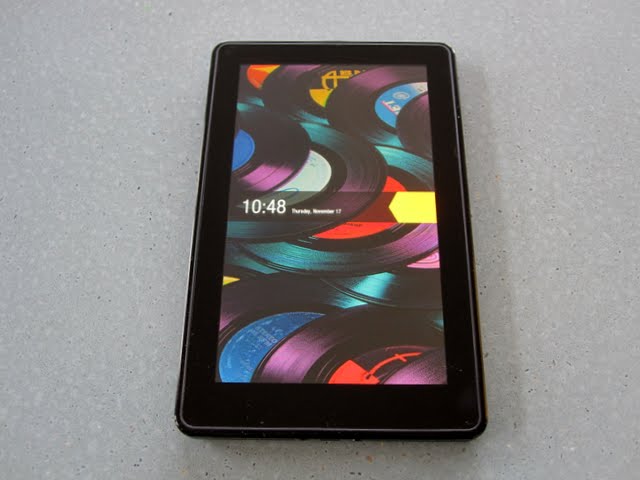For $199, there is no denying that the Kindle Fire is one of the least expensive tablets on the market right now. For the same price as an iPad, you can get two of these and still have a hundred dollar bill left over. There are not many competitors in this particular price category right now. The nook and kobo both have an ereader in the same price range, but outside of that most tablet computers start at least double the price of the Kindle Fire.
The first impression that you have when you pick up the Kindle Fire is that it's compact, but dense. It's still under a pound, but if you've just been handling the other members of the kindle family there is much more heft to the Kindle Fire. The other first impression that you'll get is that this thing is, literally, shiny. In most settings, reflections don't get too much in the way, but outdoors it can be difficult to read the screen. It's very much the polar opposite of the E-Ink displays which thrive in direct sun. The back is a soft touch plastic which is great at keeping it in place: You can easily set this up on a counter without worrying that it's going to slip. On the exterior, there are two speakers, a standard audio jack, a micro USB port, and a power button. Everything else is done via the touch screen. For included accessories, I was really disappointed to see that Amazon chose to go with a full fledged wall wart for a charger. The previous USB power adapter that was shipped with the Kindle Keyboard took less room and was more useful than this thing.
 |
| Why? |
Out of the box, the first 15 minutes of using the Kindle Fire is astounding. You simply connect to a wireless network, enter your user information (unnecessary if you order from Amazon, since they preregister your Kindle) and suddenly all of your media is there. When you activate your Kindle Fire, you're given a trail subscription to Amazon Prime, which gives the Kindle Fire a significant edge over the competition. With Amazon Prime, you can stream movies to your Kindle for free and this feature works right out of the box. Within 5 minutes of playing with the Kindle Fire, I was watching The Girl with the Dragon Tattoo for free. Most of the movies are not recent blockbusters, but there are some great ones in the free catalog. Music is also just as easy. You upload you music to Amazon and then your entire music collection is right there on your Kindle ready to be streamed. It works the same way for books as well: You can see all of the ebooks you own via Amazon and download them with a single click. Amazon has done a great job of eliminating the local/cloud barrier with the Kindle Fire.
 |
| The Video Portal |
 |
| Find a movie you like... |
 |
| ...and 15 second later you are watching it. |
 |
| The catalog includes TV Shows and Feature Films |
 |
| All of the MP3s you upload to Amazon are available in the Music section for instant streaming |
Video and music is great, but I found that the experience of using the Kindle Fire for reading was uninspiring. It felt just like the Kindle application for my android phone and left out many of the new features that have made their way to the Kindle Touch (click for my review of that device). No x-ray. No facebook/twitter sharing of quotes. Reading on the LCD screen is on par for similar devices, but E-Ink is still much better when it comes to actually reading an ebook. However, one area where the Kindle Fire definitely beats out the Kindle Touch is in regards to handling PDFs. Reading PDFs on any of the other Kindles is a chore, but the Kindle Fire makes it easy. The only down side is that you can't make notations or take notes like you can in the ebook. Also missing from the reader is text to speech, which the Kindle Keyboard and Kindle Touch both have.
Another key selling point has been that the Kindle Fire does double duty as an internet tablet with android applications. Downloading applications from the Amazon market is fine, but there are many applications that are missing from the store. For example, MapDroyd isn't there and the actual Gmail application isn't there. Angry Birds is there (don't worry) and their choice to include Pulse as a default app is great. If you haven't seen the news aggregation app Pulse, go get it now! What's worse is that some basic android apps are missing too: No clock? No Google Maps? No Youtube? These should be there. The browser is capable, but I haven't seen any real evidence of it being significantly faster due to the "silk" technology. It is possible to load applications on the Kindle via "sideloading" which are not available in the market and to Amazon's credit it doesn't seem like they've gone out of their way to make it difficult. My hunch is that they just wanted to ensure a "safe" market place a la Apple, but in reality it just adds another layer of work. For example, YouTube can be accessed via the browser, but playback was less than stellar. So, I sideloaded the YouTube app via the steps here and the apk here, and suddenly YouTube is working as you would expect. That's somewhat of a let down: If you remove an application, whatever you replace it with needs to be just as good or better. In some cases, this is not the case in the Kindle Fire, but at least you have the option to fix it yourself.
Thinking of one of the other Kindles? Read my review of the Kindle Keyboard and Kindle Touch here!











No comments:
Post a Comment